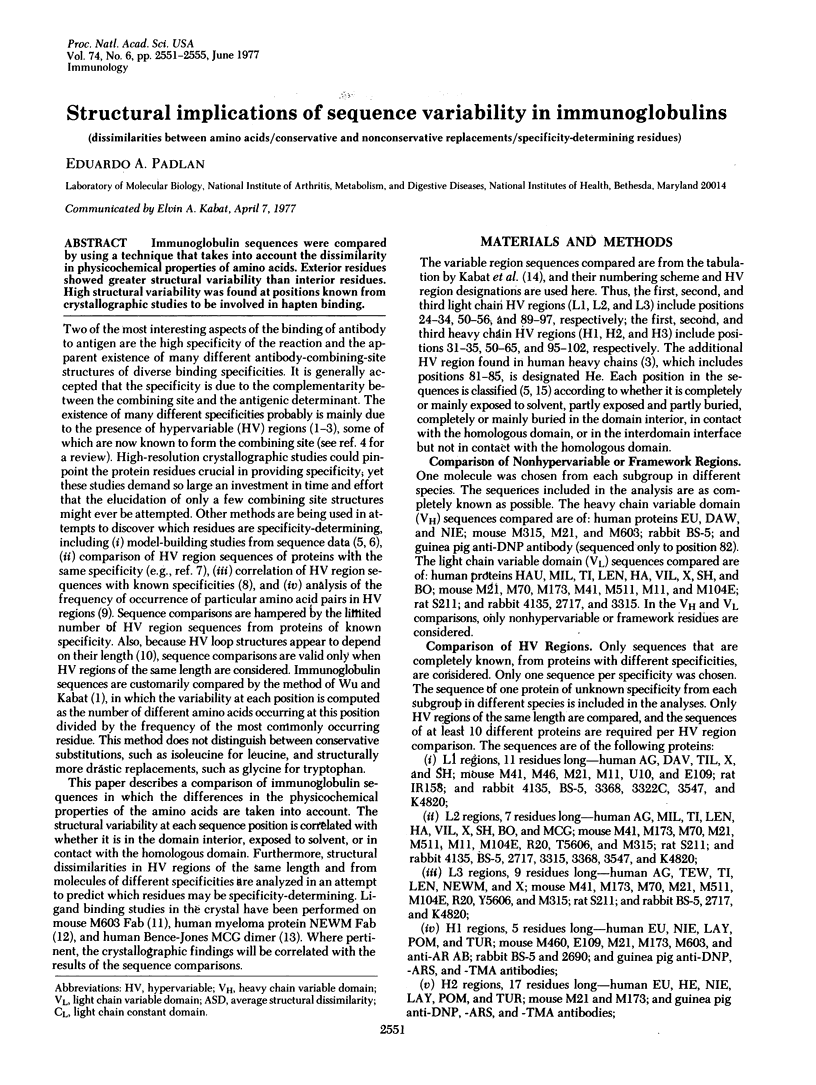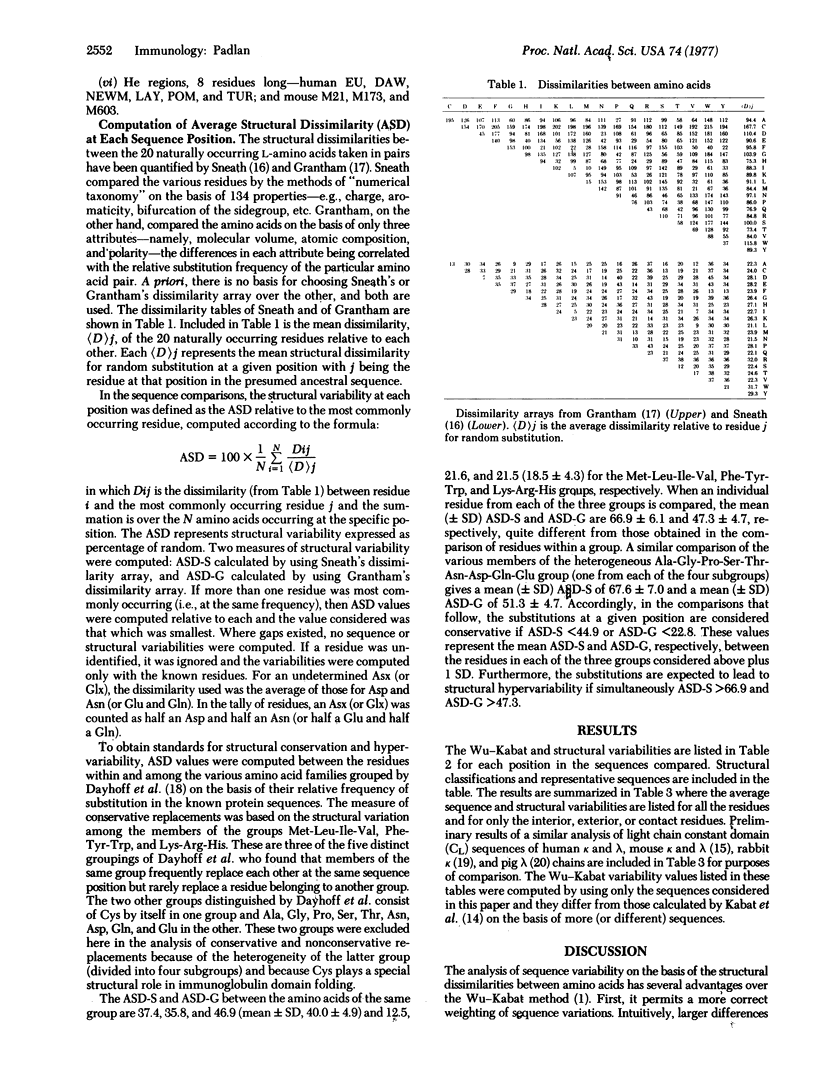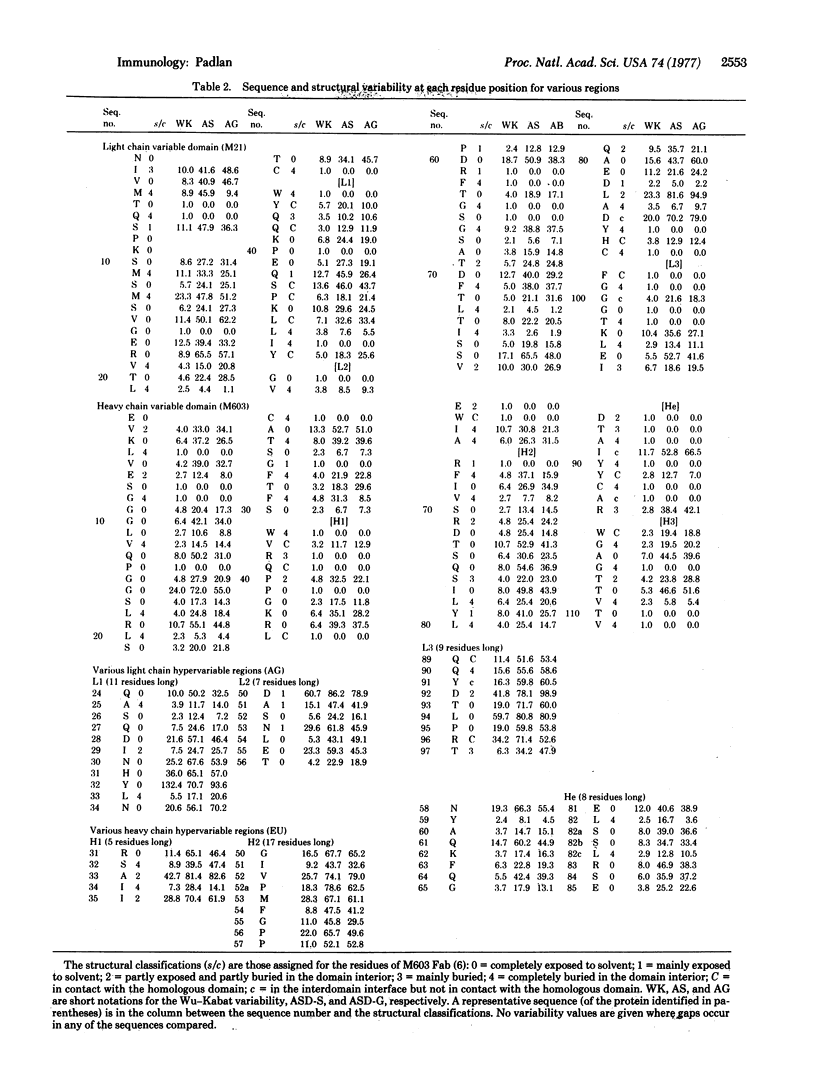Abstract
Immunoglobulin sequences were compared by using a technique that takes into account the dissimilarity in physicochemical properties of amino acids. Exterior residues showed greater structural variability than interior residues. High structural variability was found at positions known from crystallographic studies to be involved in hapten binding.
Full text
PDF




Selected References
These references are in PubMed. This may not be the complete list of references from this article.
- Amzel L. M., Poljak R. J., Saul F., Varga J. M., Richards F. F. The three dimensional structure of a combining region-ligand complex of immunoglobulin NEW at 3.5-A resolution. Proc Natl Acad Sci U S A. 1974 Apr;71(4):1427–1430. doi: 10.1073/pnas.71.4.1427. [DOI] [PMC free article] [PubMed] [Google Scholar]
- Capra J. D., Kehoe J. M. Variable region sequences of five human immunoglobulin heavy chains of the VH3 subgroup: definitive identification of four heavy chain hypervariable regions. Proc Natl Acad Sci U S A. 1974 Mar;71(3):845–848. doi: 10.1073/pnas.71.3.845. [DOI] [PMC free article] [PubMed] [Google Scholar]
- Chen K. C., Kindt T. J., Krause R. M. Amino-acid sequence of an allotype b4 light chain from a rabbit antibody to streptococcal carbohydrate. Proc Natl Acad Sci U S A. 1974 May;71(5):1995–1998. doi: 10.1073/pnas.71.5.1995. [DOI] [PMC free article] [PubMed] [Google Scholar]
- Davies D. R., Padlan E. A., Segal D. M. Three-dimensional structure of immunoglobulins. Annu Rev Biochem. 1975;44:639–667. doi: 10.1146/annurev.bi.44.070175.003231. [DOI] [PubMed] [Google Scholar]
- Edmundson A. B., Ely K. R., Girling R. L., Abola E. E., Schiffer M., Westholm F. A., Fausch M. D., Deutsch H. F. Binding of 2,4-dinitrophenyl compounds and other small molecules to a crystalline lambda-type Bence-Jones dimer. Biochemistry. 1974 Aug 27;13(18):3816–3827. doi: 10.1021/bi00715a031. [DOI] [PubMed] [Google Scholar]
- Epp O., Colman P., Fehlhammer H., Bode W., Schiffer M., Huber R., Palm W. Crystal and molecular structure of a dimer composed of the variable portions of the Bence-Jones protein REI. Eur J Biochem. 1974 Jun 15;45(2):513–524. doi: 10.1111/j.1432-1033.1974.tb03576.x. [DOI] [PubMed] [Google Scholar]
- Grantham R. Amino acid difference formula to help explain protein evolution. Science. 1974 Sep 6;185(4154):862–864. doi: 10.1126/science.185.4154.862. [DOI] [PubMed] [Google Scholar]
- Kabat E. A., Padlan E. A., Davies D. R. Evolutionary and structural influences on light chain constant (CL) region of human and mouse immunoglobulins. Proc Natl Acad Sci U S A. 1975 Jul;72(7):2785–2788. doi: 10.1073/pnas.72.7.2785. [DOI] [PMC free article] [PubMed] [Google Scholar]
- Kabat E. A., Wu T. T. Attempts to locate complementarity-determining residues in the variable positions of light and heavy chains. Ann N Y Acad Sci. 1971 Dec 31;190:382–393. doi: 10.1111/j.1749-6632.1971.tb13550.x. [DOI] [PubMed] [Google Scholar]
- Kabat E. A., Wu T. T., Bilofsky H. Attempts to locate residues in complementarity-determining regions of antibody combining sites that make contact with antigen. Proc Natl Acad Sci U S A. 1976 Feb;73(2):617–619. doi: 10.1073/pnas.73.2.617. [DOI] [PMC free article] [PubMed] [Google Scholar]
- Kabat E. A., Wu T. T., Bilofsky H. Some correlations between specificity and sequence of the first complementarity-determining segments of human kappa light chains. Proc Natl Acad Sci U S A. 1976 Dec;73(12):4471–4473. doi: 10.1073/pnas.73.12.4471. [DOI] [PMC free article] [PubMed] [Google Scholar]
- Margolies M. N., Cannon L. E., 3rd, Strosberg A. D., Haber E. Diversity of light chain variable region sequences among rabbit antibodies elicited by the same antigens. Proc Natl Acad Sci U S A. 1975 Jun;72(6):2180–2184. doi: 10.1073/pnas.72.6.2180. [DOI] [PMC free article] [PubMed] [Google Scholar]
- Novotný J., Franek F. Different degrees of interspecies homology in immunoglobulin lamda chain constant domain correlated with three-dimensional structure. Nature. 1975 Dec 18;258(5536):641–643. doi: 10.1038/258641a0. [DOI] [PubMed] [Google Scholar]
- Padlan E. A., Davies D. R., Rudikoff S., Potter M. Structural basis for the specificity of phosphorylcholine-binding immunoglobulins. Immunochemistry. 1976 Nov;13(11):945–949. doi: 10.1016/0019-2791(76)90239-1. [DOI] [PubMed] [Google Scholar]
- Padlan E. A., Davies D. R. Variability of three-dimensional structure in immunoglobulins. Proc Natl Acad Sci U S A. 1975 Mar;72(3):819–823. doi: 10.1073/pnas.72.3.819. [DOI] [PMC free article] [PubMed] [Google Scholar]
- Poljak R. J., Amzel L. M., Avey H. P., Chen B. L., Phizackerley R. P., Saul F. Three-dimensional structure of the Fab' fragment of a human immunoglobulin at 2,8-A resolution. Proc Natl Acad Sci U S A. 1973 Dec;70(12):3305–3310. doi: 10.1073/pnas.70.12.3305. [DOI] [PMC free article] [PubMed] [Google Scholar]
- Segal D. M., Padlan E. A., Cohen G. H., Rudikoff S., Potter M., Davies D. R. The three-dimensional structure of a phosphorylcholine-binding mouse immunoglobulin Fab and the nature of the antigen binding site. Proc Natl Acad Sci U S A. 1974 Nov;71(11):4298–4302. doi: 10.1073/pnas.71.11.4298. [DOI] [PMC free article] [PubMed] [Google Scholar]
- Sneath P. H. Relations between chemical structure and biological activity in peptides. J Theor Biol. 1966 Nov;12(2):157–195. doi: 10.1016/0022-5193(66)90112-3. [DOI] [PubMed] [Google Scholar]
- Wu T. T., Kabat E. A. An analysis of the sequences of the variable regions of Bence Jones proteins and myeloma light chains and their implications for antibody complementarity. J Exp Med. 1970 Aug 1;132(2):211–250. doi: 10.1084/jem.132.2.211. [DOI] [PMC free article] [PubMed] [Google Scholar]


